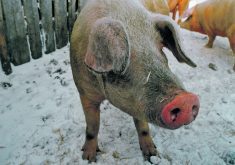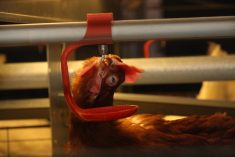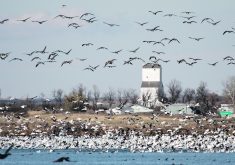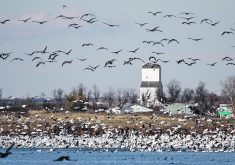Recent cases rattle U.S. producers, who remember a devastating outbreak in 2015 that killed nearly 50 million birds
CHICAGO, Ill. (Reuters) — American poultry producers are tightening safety measures for their flocks as disease experts warn that wild birds are likely spreading a highly lethal form of avian flu across the country.
Indiana reported earlier this month that the highly pathogenic bird flu was found on a commercial turkey farm, leading China, South Korea and Mexico to ban poultry imports from the state. The outbreak put the American industry on edge at a time that labour shortages are fuelling food inflation.
As well, a flock of about 240,000 chickens owned by Tyson Foods in Kentucky has tested positive, widening an outbreak that threatens the U.S. poultry industry.
Read Also

New coal mine proposal met with old concerns
A smaller version of the previously rejected Grassy Mountain coal mine project in Crowsnest Pass is back on the table, and the Livingstone Landowners Group continues to voice concerns about the environmental risks.
Infections in the chickens being raised for meat triggered more restrictions on U.S. exports, with China blocking poultry products from Kentucky.
The broiler chickens in Fulton County, Kentucky, located near the border with Tennessee, were infected with the same H5N1 strain of highly pathogenic avian flu as the turkeys in Indiana, Kentucky officials said.
They said it is Kentucky’s first outbreak of the highly lethal bird flu.
Birds from the infected flock will be culled and will not enter the food system, state officials said.
Tyson Foods is working with government authorities to prevent the disease from spreading and is heightening safety measures at other local farms, spokesperson Gary Mickelson said.
The outbreak is not expected to lower overall chicken production levels because thousands of farms raise chickens for Tyson, he said. Mickelson added that Tyson Foods’ chicken products are safe to eat.
The disease was also detected in a backyard flock of birds in Virginia’s Fauquier County, which have already been culled, the U.S. Department of Agriculture said. The cases do not present an immediate public health concern, the agency said.
The disease is already widespread in Europe and affecting Africa, Asia and Canada, but the outbreak in Indiana, which is on a migratory bird pathway, particularly rattled American producers.
A devastating bird-flu outbreak in the United States in 2015 killed nearly 50 million birds, mostly turkeys and egg-laying chickens in the Midwest.
The U.S. is the world’s largest producer and second-largest exporter of poultry meat, according to the U.S. government.
“Everyone is just sitting on edge because we know what can happen and we don’t want a repeat of that,” said Denise Heard, vice-president of research for the U.S. Poultry and Egg Association.
Poultry company Perdue Farms suspended in-person visits to farms to avoid spreading the disease, spokesperson Diana Souder said.
Iowa’s agriculture secretary Mike Naig said a confirmed case in the country meant heightened risk for all.
“It’s time to move to a higher alert for our livestock producers,” Naig said.
Disease experts said a wild bird likely spread the H5N1 virus, which can be transmitted to humans, to Indiana from the East Coast, where officials have confirmed that wild ducks were infected with the strain.
The U.S. Department of Agriculture called the disease low risk to people.
Tyson Foods Inc. heightened biosecurity measures in its East Coast facilities after the wild bird infections, the company said. It said it reduced the number of trips to farms and started taking more time to clean vehicles.
Wild birds from the East Coast may have mixed with those that fly through a migratory path called the Mississippi Flyway, which includes Indiana and major poultry-producing states, such as Mississippi and Alabama, experts said.
To better track the disease, the USDA said it will expand monitoring of wild birds to the Mississippi Flyway and another migratory pathway.
Other commercial poultry flocks may become infected as wild birds traverse flyways, though producers have improved safety measures since 2015, said Carol Cardona, an avian health professor at the University of Minnesota.
There have been more than 700 outbreaks of bird flu in Europe, with more than 20 countries affected since October 2021. Tens of millions of birds have been culled.
Britain’s government reported that the country was suffering its worst-ever bird flu season, while Italy has the highest number of outbreaks at more than 300. Hungary, Poland and France have also recorded significant numbers of cases.
The disease hit the U.S. at a time when poultry supplies are down due to strong demand and labour shortages at meat plants during to the COVID-19 pandemic.
Government data showed U.S. frozen chicken supplies were down 14 percent from a year ago at the end of December while turkey inventories were down 23 percent.
In Indiana, officials are testing poultry farms in a 10-kilometre control area around the infected farm in Dubois County. The state said all tests were negative but that testing will continue on a weekly basis.
Those negative tests have not relaxed James Watson, the state veterinarian in Mississippi, the fifth-biggest chicken-meat-producing state. He said wild ducks will likely continue to spread the virus until warmer weather sends them to northern breeding grounds.
“Even if they resolve this with no other issues, we’re still going to be on high alert,” Watson said.

















